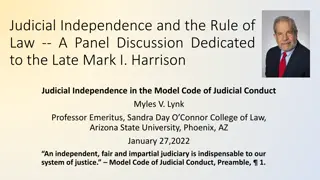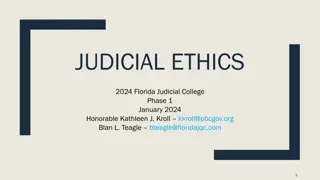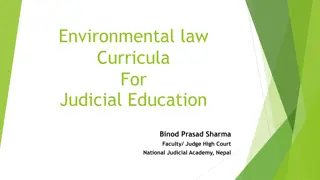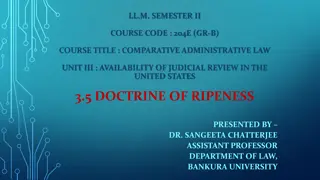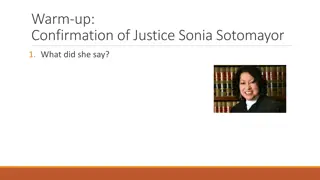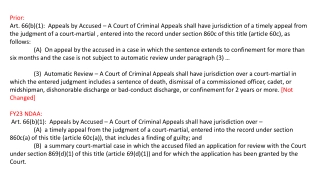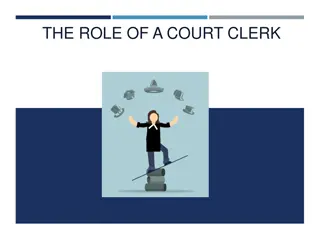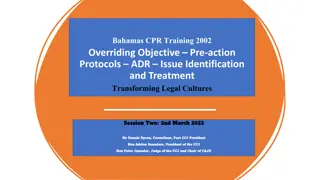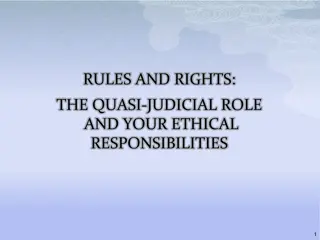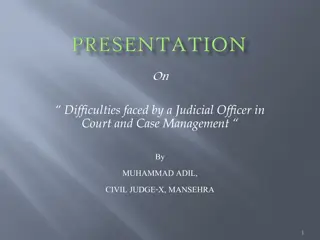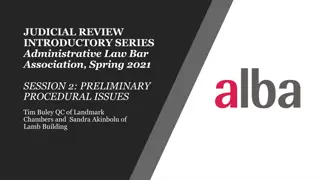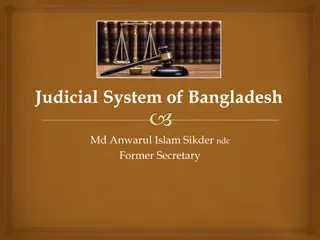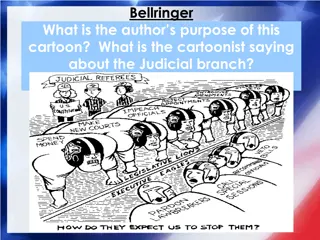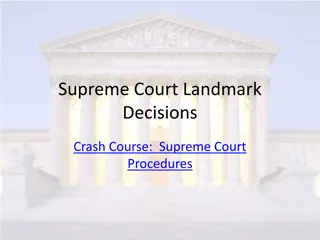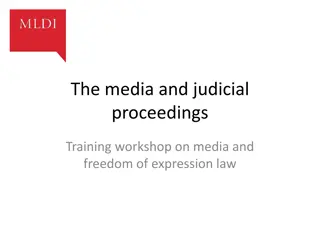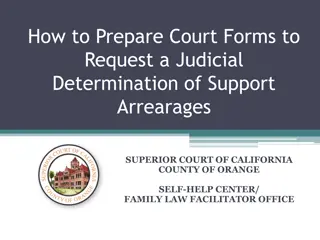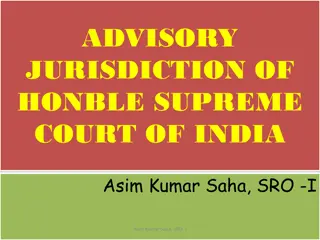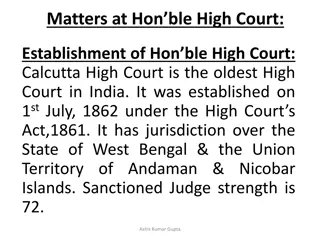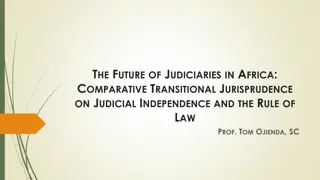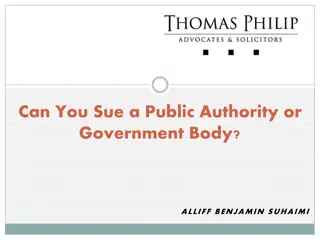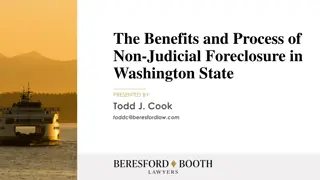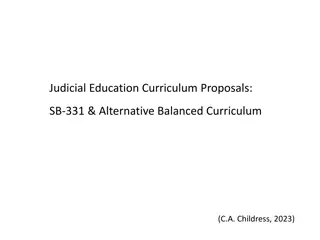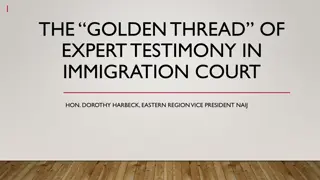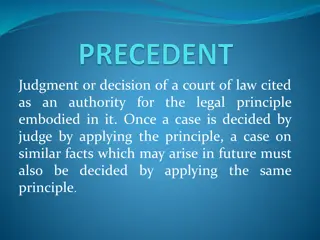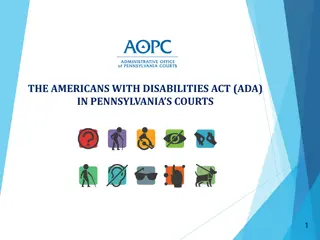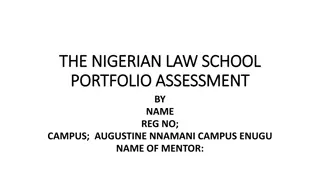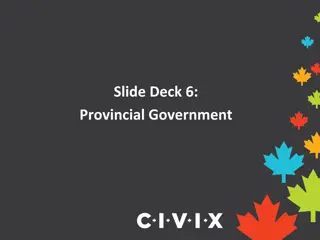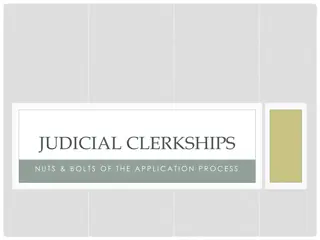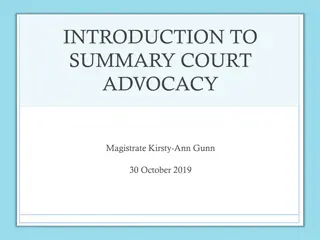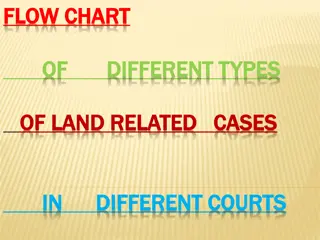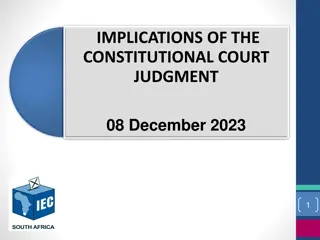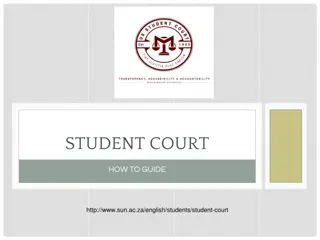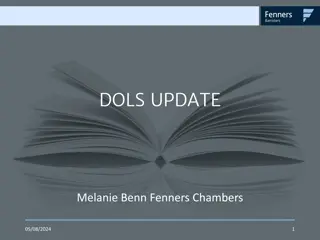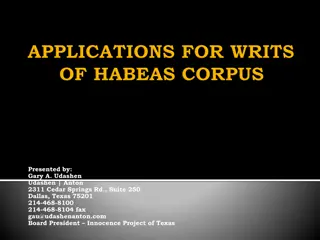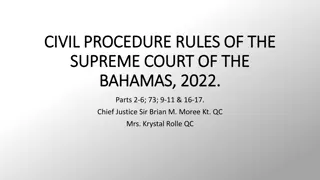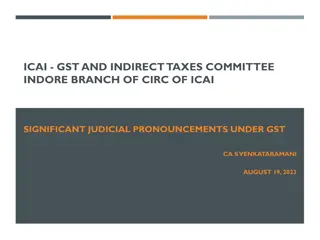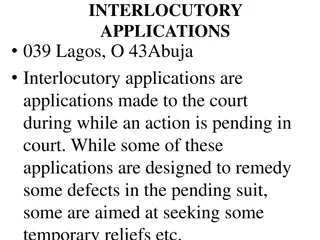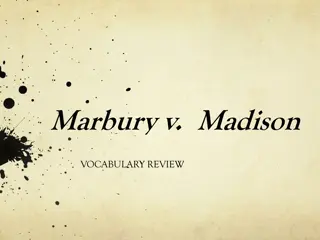Essential Responsibilities and Management in Judicial Court System
Explore the vital aspects of maintaining judicial records, court management, judge responsibilities, and court work division in the judicial system. Learn about the skill sets required for effective court management, essential duties of a judge, and the administrative functions involved in the judicial process.
Download Presentation

Please find below an Image/Link to download the presentation.
The content on the website is provided AS IS for your information and personal use only. It may not be sold, licensed, or shared on other websites without obtaining consent from the author. Download presentation by click this link. If you encounter any issues during the download, it is possible that the publisher has removed the file from their server.
E N D
Presentation Transcript
MAINTENANCE OF JUDICIAL RECORD BY: ILYAS SAEED CIVIL JUDGE/JUDICIAL MAGISTRATE XI, DISTRICT COURTS, MANSEHRA. ---------------------------------
M MANAGEMENT ANAGEMENT: The skill or practice of controlling, directing, or planning, especially a business, institution. Court management; comprised of a. Self-management. (attitude, knowledge of law & facts, passion, code of conduct) b. Time-management. (attendance, classification of cases) c. Stress-management. (to avoid, do plan) d. Case flow management. (prioritization) e. Maintenance of record f. Correspondence ---------------------------------
RESPONSIBILITIES OF A JUDGE Every Judicial Officer is responsible for: Supervision of his establishment, court work - Due observance of law and the orders - Work of attached ministerial staff - Proper maintenance of the Files, Registers and Accounts - Correspondence through official channel - All pecuniary transactions, to be conducted in presence of a judicial officer - Valuation of suits and Court Fee - Timely and correct consignment of Record - Assets of the Court, furniture, library, equipment's etc. - Time Bound disposal of case and delay - Implementation of Code of Conduct - -----------------------------------
Court Work, Division Judicial Administrative (a) Judicial Registration Process Diary Management Scrutiny & admission mechanism (Prima facie, Valuation, Limitation, Court Fee, Legal Bar etc) Process & attendance (publication) Defense version (written statement, rejoinder, cross objection) Miscellaneous application (injunctions, amendment) Issues & list of witnesses Evidence, Rules of caution (Penal provision, ousting co-oral witness, authenticity of documents, STOs, documents, dictation) Hearing Arguments (notes, case law, prior study) Judgment (issue wise, reasoning, appreciation, law, decree sheet) Decree sheet Consignment
(b) Administrative Registers Library Correspondence Record Meeting minutes Confessions Deposits Fines Inspection Notes Fortnightly & monthly reports Cause Lists Assets, Equipment & Accessories
WHY NEED INTEGRATED APPROACHED TO RECORD MANAGEMENT? - Lack of uniform classification and filing system. - Lack of systematic and orderly transfer of inactive records. - Lack of standardization and control to the creation of record. - Loss or misfiling of records. - Lack of storage space and filing equipment. ---------------------
MAINTENANCE OF RECORD - Definitions - Record: - Information captured in reproducible form required for conducting any transaction or activity. - Maintenance: - A logical and practical approach towards creation, keeping, use and disposition of records. -----------------
OBJECT: Maintenance of true, correct and proper record of Judicial Proceedings is essential for safe administration of justice and for safeguarding valuable rights of citizens. - Application of judicial mind can only be ensured when diligently prepared correct record is easily -------------------------
GOALS - Create only necessary for efficient and successful operation of the system. - Timely production of the record when needed. - Retain/preserve only records needed for continued operation of the institution and dispose what is not needed. --------------------------
Life Cycle Concept - Record pass through three main stages from its creation and active use to its final disposition. Basic Categories: - Active - Inactive - Dead -------------------------------
Instructions about Size and Quality of Paper High Court Rules & Orders Volume-IV Ch:16 - All copies of judicial documents, all applications and petitions should be written on the standard pattern water marked petition paper. - Paper to be kept flat at its full size (13 X 8 ) - Foolscap paper, should be used for all English portion of the record and to be kept flat - B Quality paper to be used for process - Economy to be exercised in use of paper - Registers to be obtained from Official Printing Press - Uniform size of paper for Records
Advantages of Uniform size of Records - Facilitation in compilation - Space saving in Record Room by making the files into compact and even block. - Protection from injury from constant use and while in transit, as papers of one size are less easily frayed at the edges by being tied out, untied, and are less liable to be get folded, torn and damaged in general use. ____________________________________
Instructions to Prevent Waste Except in warrant cases and Civil Suit, depositions of witnesses be written - continuously instead of separate sheets. A clear space of 2/3 inches be left blank between the end of one statement and the - beginning of the next. The practice of writing orders and other matters across the top and along with the - sides of a page should be discontinued. Reasonable margin should be left on each side of the paper, so that writing may not - be obliterated by fraying at the edges. ------- Continue ---------------
Continue Files in use in court should be placed between stiff wooden or cardboard protectors of the size of the standard file, so that the strain of the cloth or covering, or of the string or tape, does not fall in the papers within. - Each file be tied with broad tape or nawar instead of string. - Each bundle of files should, until packed away in the Record Room, be kept between stiff covers to prevent fraying, folding etc. - English record and papers be placed at their full size in envelops of the size of file. - Exhibits should be folded to as nearly as possible the same size and placed in envelops of the size of the file. -
REGISTERS High Court Rules & Orders Volume-IV Ch:24 High Court Rules and Orders of 1902 and Standing Orders of the Judicial Commissioner, NWFP (KPK) 1937 direct Courts to maintain (printed) registers for different purposes. -------------------
Important Registers to be maintained by Moharrir of a Civil Judge Civil Suits No. - I - Divorce and Matrimonial cases, No. - III - Register of Probate, LOA and Succession, No. - V (Where empowered) - Miscellaneous, No. - VI - Pauper, all Civil Courts, - VII - Review, all Civil Court, - XII - Register of Imprisoned JD, all courts, - XVI - Relating to Property of Minors, - XXVI (if empowered) - Transferred Decree, all courts. - XXXIII Execution Moharrir - Execution of Decrees, - X - Miscellaneous Petitions in Execution, - XI -
To be maintained by Reader - Rejected and Returned Plaints and Appeals. - VIII - Register of Dates. - IX - Persons Punished for contempt of Court. - XVII - Stamp Deficiencies. - XVIII - Commissions. - XIX - Register of Returned Documents. - XXIV - Deposit and Refund of Commission on sale proceeds in execution - XXV -------------------------------
List of Criminal Registers To be maintained by Moharrir of Judicial Magistrate Register of complaint, cognizable and non-cognizable offences - I - PPC offences. - II - Special and Local Laws. - III - Miscellaneous - IV - Decided Cases. - V - Register of under trial Prisoners. - XII - Register of Fines. - XIV - Realized Fines. - XV - Prisoners Released, or of reduced punishment. - XIX - Traffic cases. - XXI - To be maintained by Reader Register of Dates. - XI - Summary Trials. - XVII - Diet money of witnesses. - XVIII -
Miscellaneous Registers General orders issued for guidance, with date of issuance. - E (Reader) - Miscellaneous Proceedings received from other Courts. - C (Moharrir) - Dispatch. - D (Moharrir) - Affidavits. - I (Reader) - Register Dak. - K DSJ English Clerk SCJ Civil Nazir - Register of General Correspondence, - I English Clerk - Register of Ministerial Staff, - G DSJ English Clerk SCJ Clerk of Court - Register of Petition Writers, - H DSJ English Clerk - -------------------------------
Registers to be maintained by Record Keeper - General Register of Suits and Appeals disposed of (Civil) - XV - Returned Documents. - XXIV - General Register of Decided cases (Criminal) - XVI - Register of Files taken from the Record Room, - B (Miscellaneous)
RECORDING Preparation and compilation for consignment Arrangement of Files A and B with separate index - General Index to remain on File A, containing particulars of contents of File B - Consignment in two files. - Folded papers be straitened, repaired. - Papers to be numbered, each sheet of a paper consisting upon more than one sheet should be marked. - Note of withdrawn documents used in evidence, whether before or after judgment, should be made in the column of remarks. - Certificate on the index to be signed by the Moharrir and countersigned by the Presiding Officer. - Dispatch, through docket/challan, to Record Room. - Entry of consignment number in the relevant register of the case. - -----------------------------------
Indexation - Each Civil and Criminal record should have prefixed to it an index of its contents. - Each paper admitted to the file should be entered in the index on the day it is so admitted by the In charge of the file. - Name of the deponent be entered in deposition sheet - Page Numbering. Index to be in two parts - First containing a list of the papers belonging to File A - The second, a list of the papers belonging to File B
Consignment: Examination of File by record keeper, entries of index. - Signing of Certificate, if file complete at the foot of index. - Entry in the appropriate register. - Entry in Dispatch/Challan register of the Court and return. - Dispatcher and Receiver of Judicial Files should be an authorized official - Transmission of file to another office/court, list to be prepared in duplicate upon requisition slip and signature of dispatcher to be obtained. - Duplicate list by the receiving official with signature. - Bundles. - Weeding, sorting out for destruction. -
Preservation of Record, measures. - Sufficient equipment, Almirahs, steel shelves, wooden boards, cotton strap. - The Shelves/Record Room is to be kept free of rats, dirt, dust and direct sunlight. - Periodical spray with insecticide. - Computerization of consigned record. -----------------------------------
Classification of Records All Civil and Criminal records shall be arranged in separate Files, A, Ai, and B Civil Record File A, shall contain The index of Papers The order sheets Plaint together with schedule annexed and all document annexed The written statement, Rejoinder etc Application of parties strangers to the suit and court s order thereon (Ai) Reports of Record Departments (Ai) Orders of arrest or attachment before judgment with all document (Ai) Application for Review and court s order (Ai) Copies of Civil, Revenue and Municipal record received as evidence (Ai) Issues All Dispositions of witnesses Documentary evidence Commissions Reports Applications for referral to Arbitration and the award along with all annexures Deeds of withdrawal, compromise The judgment or the Final order The Decree Judgment and Decree of Appellate Courts All orders passed in Execution, with all objections, notices and reports of service thereon All receipts of acknowledgement filed in execution All notes in handwriting of the Judge
(.continued)Civil Record File A, shall contain Appeals The index of papers The order sheets The petition of Appeal Copies of Judgments and decrees of lower courts Cross objection Issues referred for trial Commissions Any additional evidence Withdrawal deeds and compromise The judgment/final order Any judgment and decree of a superior court Power of attorney of counsel or agent of the parties
File B All papers not included in File A and Ai, applications, process etc -----------------------------------
Criminal Record Part A Sessions Trial The index The order sheets The charge All Depositions of witnesses, statements All documentary evidence The final order/judgment Notes of the Judge Any order of High Court Warrants returned after execution All proceedings relating to realization of Fines Power of attorney of counsel or agent of the parties -----------------------------------
Part A Magisterial Trial and Inquiries The index The order sheet Challan/complaint All Depositions All documentary evidence Charge Final order Notes of the Magistrate The judgment of the Appellate or Revisional Court Fine Recovery Proceedings Bonds u/s 110 Cr.PC _____________________
In Appeal Cases The index Order sheets Appeal petition Copy of judgment of Lower Court Additional evidence The Notes The Final order Criminal Record Part B ----------------------------------- All papers not included in File A, applications, process etc
Classification of Records in terms of Preservation KEEP FOREVER All suits and appeals involving the tile to immovable property Suits and appeals relating to the succession to an office, or to establish or set aside adoption All suits and appeals relating to trusts or religious endowments Records of attachment, sale and delivery of immovable property in execution of decrees, including all objections and orders thereon Proceedings under the Succession Act, 1925 Proceedings under the Divorce Act (MFLO/FCA) Correspondence record on matter connected with the administration of justice, annual reports. (However, may be destroyed after 3 years with the previous sanction of the District Judge) -----------------------------------
Keep Preserved for 50 years File A of The cases relating to any of offences specified in Section 44 of Cr.PC (Provided if it is known that the offender concerned is dead then the record may be destroyed. Untraced Criminal Cases punishable with death sentence Adjourned cases against lunatics, unless have subsequently been tried or dead -----------------------------------
Keep preserved for 20 years Sessions cases if the sentence executed and warrant returned The charge, finding and sentence in cases of conviction, to be relied upon for enhanced punishment in subsequent conviction Cases against public servant, whatever may have been the result -----------------------------------
Keep preserved for 12 years Insolvency proceedings under chapter XX of the CPC ____________________
Keep preserved for 6 years All civil suits and appeals (other than that to be preserved in perpetuity) if the decree has been executed or finally held incapable of execution Cases tried under Section 30 Cr.PC, if sentence has been executed in case of conviction Records relating to realization of fines -----------------------------------
Keep preserved for 3 years File A of Criminal cases tried by Magistrates Appeals against orders of Magistrates All correspondence between the District Judge and subordinate Courts Other records, periodical statements, reports, proceedings, application, not expressly provided for in these rules. However, may be retained by special orders -----------------------------------
Keep for 1 year File B of all civil and criminal cases and appeals Proceedings of other courts, forwarding notices, proclamation, calling for records etc. -----------------------------------
How to calculate the period Be taken to run from the date of the final orders of the court of first instance, or in the event of an appeal from that of decision of the appeal -----------------------------------
DESTRUCTION OF JUDICIAL RECORD Vol-IV Ch:16 Part-F Rules Framed, by the chief Court, confirmed by the Government and sanctioned by the Governor General of India, Under Powers conferred by Section 5 of the Destruction of Records Act, 1879, Repealed by Destruction of Record Act, 1917, whereafter under Section 3 of the Act Lahore High Court made Rules for destruction of records. -----------------------------------
Procedure of Destruction Obsolete records and Registers to be destroyed in September every year Before destruction of File A record of all private document belonging to private persons or to Government, parties to proceedings, shall be preserved and tied up in a separate parcel and notices, as far as practicable, be given to the persons, who produced them, requiring them to take back within six months from the date of notice. They are also warned about the consequences All court fee stamps be cancelled before destruction Destruction by tearing and soaking in water Destroyed papers be sold out/forwarded to the nearest Jail Superintendent Sale proceeds, if any, be deposited in the treasury and accounts be maintained A note of every record destroyed shall be made on the register in which the case is registered, under signature of a responsible officer Record of destruction to be maintained by record keeper -----------------------------------
Destruction of Registers From the date of last entry Registers to be destroyed after 12 years Civil Registers No. X and XIV Execution of decrees - Miscellaneous Appeals - Criminal Register No. I, III, IV and XVII - Complaint, cognizable or non-cognizable cases - SP and Local Laws - Miscellaneous - Summary trials -----------------------------------
Registers to be destroyed after 6 years Civil Registers No. XVI, XVII, XIX, XXII Register of JDs imprisoned - Register of stamp deficiencies - Commissions - Register of warrants executed by Bailiffs - Criminal Register No. XVI and XVII General Register of decided cases (Record keeper) - Register of diet money - Civil and Criminal Register C and D Miscellaneous Proceedings - Dispatch Register - -----------------------------------
Registers to be destroyed after 3 years - - - - - - - - - - - - - - - - - - - Civil Registers No.VII, VIII, IX, XII, XVII, XXIII, XXIV, XXV Pauper applications Rejected and returned plaints Register of Dates Review Stamp Deficiencies Contempt of Court Served Process by Process Server Returned Documents Deposit and Refund of commissions in Executions Criminal Registers No.V, VI, XIII, XIV, XV and XIX Register of decided cases Annual Returns (not maintained) Persons admitted to and removed from court lock-ups Register of Judicial Fines Register of Realized Fines Released Prisoners, Punishment reduced Civil and Criminal Registers. E, F, G, H Register of General orders issued by High Court Register Property in Nazir s Store Room Register of Ministerial Staff Register of Petition writers -----------------------------------
No other Judicial Register to be destroyed. -----------------------------------
Summary The ultimate test of a good record maintenance program is whether the records are available to those who need them, when and where they are needed (Effectiveness), the manner in which they are made available (Efficiency), and at what cost (Economy). -------------------------


